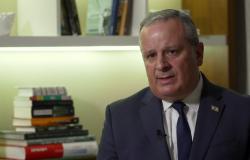In recent years, we have seen how geopolitical unrest affects both security and the economy. War is primarily cruel where it takes place. Russia’s war in Ukraine also affects the large economic machinery, so that the war is also visible on the cash registers in Norwegian convenience stores.
Even before Russia attacked Ukraine, international price inflation was on the rise. The war reinforced this situation, particularly through increased energy and food prices. It became clear to us that there would be demanding economic times.
In the government’s security committee, where a bunch of ministers decide on sensitive and serious information about the security situation in the world and in Norway, we had several meetings ahead of the attack that made a big impression. When the attack was a fact, the government agreed to stand up for Ukraine. We knew it would cost. In addition, we knew that the new security policy situation could have dramatic consequences for the Norwegian economy.
One of my big concerns in 2022 was that ordinary families would not manage financially through the times we were facing. Historically, periods of high price growth have brought with them high unemployment. If you lose your job income, servicing the mortgage can be difficult. This can be particularly noticeable in Norway, where a large proportion of households own their own home and have high debt with floating interest rates.
My fear was that we would once again experience what we experienced in the early 1990s. Many Norwegians then had to leave their homes with great losses, and subsequent debt problems.
The government made a plan for how we were going to take the country safely through the predicted animal age. Central to it was creating security for people’s everyday finances.
Due to the electricity price crisis, sharp price increases and the flow of refugees from Ukraine, we saw that expenditure on the budget had increased by around NOK 100 billion, and that we lacked more than NOK 30 billion to make the budget in 2023 come together.
We were faced with the following choices:
-
Should we cut welfare services for people? No, the only responsible thing was to help those who were hit particularly hard by increased living costs, and otherwise continue our good welfare services.
-
Should we raise taxes for people? No. The rise in prices and interest rate increases were burdensome enough for many households.
-
Should we cover the increased expenses by using more oil money? No, we had to be restrained with that, since the pressure was already great in the Norwegian economy.
At the same time, it was out of the question not to stand up for Ukraine. Both from a moral and humanitarian perspective, and out of self-interest as a small neighboring country to Russia. We had to bear these costs.
We therefore took three key measures. Moves we knew would trigger new, demanding debates:
-
We postponed several public construction projects.
-
We took some temporary tax measures.
-
We chose to increase the ground rent tax on hydropower, and to introduce a ground rent tax on aquaculture (the salmon tax) and onshore wind power.
All these measures have at least one common denominator: Ordinary people were shielded from tax increases and welfare cuts. On the contrary, we increased support for those who needed it most.
Now, barely two years later, the financial situation is better, although I know that many families still have a demanding everyday economy.
Inflation is on the way down, and Norges Bank has announced that the interest rate peak has most likely been reached. We still have low unemployment, and employment has been the highest in 15 years. What is equally gratifying is that Norwegian business life in general is doing very well.
Although the construction industry is now experiencing challenging times, other industries are doing well. Mainland companies have never before invested more than in 2023. On average, in the last two years, 6,000 new companies have been established a month.
The goal has always been to get people in Norway safely through this troubled time, without a large increase in unemployment. The last time we experienced similar price growth in Norway, it took many years before the economy got back on its feet, and unemployment remained high for a long time.
It is always scary to predict the future, but we can allow ourselves to feel that the fear of people’s everyday finances is considerably less. Now the forecasts look better. We have a clear expectation that most people will experience increased purchasing power again, and that unemployment will remain low in a historical perspective.
At the same time, we must recognize that the security situation is still serious, both for us here in Norway and for many other countries. We cannot escape the fact that this will affect us for a long time, both as people and as a nation.
The government obviously has this with us when we recently started work on next year’s state budget. Defense and preparedness will be an important priority going forward. Fortunately, we can afford to secure our country. Nor can we afford not to.
Trygve Slagsvold Vedum
Minister of Finance (Sp)






